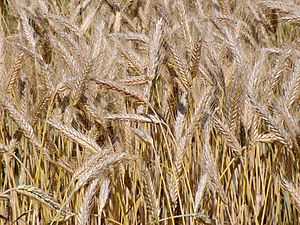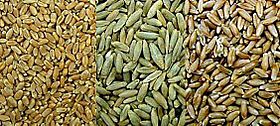Triticale facts for kids
Quick facts for kids Triticale |
|
|---|---|
 |
|
| Triticale | |
| Scientific classification | |
| Kingdom: | |
| (unranked): | |
| (unranked): | |
| (unranked): | |
| Order: | |
| Family: | |
| Tribe: | |
| Genus: |
× Triticosecale
|
| Binomial name | |
| × Triticosecale Wittm. ex A. Camus.
|
|
| Species | |
|
see text |
|
| Synonyms | |
|
× Triticale Tscherm.-Seys. ex Müntzing |
|
Triticale (× Triticosecale) is a special type of grain that is a mix of two other grains: wheat (Triticum) and rye (Secale). Scientists first created it in labs in the late 1800s in Scotland and Germany.
Most triticale you see today is a "second-generation" hybrid. This means it's a cross between two different types of the first triticale plants. Triticale is great because it combines the good things from both parents. It has the high yield (lots of grain) and good quality of wheat. It also has the toughness of rye, which means it can grow well even in difficult soil or environments.
For a long time, triticale was mostly an experiment. But recently, it has become a successful crop that farmers can grow and sell. Depending on the specific type, triticale can look more like wheat or more like rye. It's mostly grown to feed animals, like forage or fodder. However, you can sometimes find triticale in health food stores or in some breakfast cereals.
When scientists cross wheat and rye, they use wheat as the "mother" plant and rye as the "father" (it provides the pollen). The first plant they get from this cross is usually sterile, meaning it can't make seeds on its own. To fix this, they treat the plant with a chemical called colchicine. This chemical helps the plant's cells double their chromosomes, making the plant able to reproduce.
The main countries that grow triticale are Poland, Germany, Belarus, France, and Russia. In 2014, farmers around the world harvested over 17 million tons of triticale.
Contents
How Triticale is Made
Triticale plants are amphidiploid. This is a fancy word meaning they have a full set of genetic information from two different species. Think of it like having two complete instruction manuals from two different companies in one product.
Early on, scientists worked with different versions of triticale. Some were called "octoploid" and "tetraploid." These didn't work very well. But a type called "hexaploid" triticale was much more successful. This is the kind that is now grown by farmers.
Uses of Triticale
The International Maize and Wheat Improvement Center has worked to improve triticale. Their goal is to help produce more food and better nutrition in developing countries.
Triticale was once hoped to be a major ingredient for bread, cookies, pasta, pizza dough, and breakfast cereals. It has more protein than wheat. It also has higher levels of an important nutrient called lysine. However, the way triticale is milled (ground into flour) is different from wheat, so the milling industry would need to change.
Triticale is already very important as a feed grain for animals. Its starch is easy for animals to digest. Scientists are also looking into using triticale as an energy crop. They are studying how to use the plant's biomass (plant material) to make bioethanol, which is a type of fuel.
History of Triticale
In the 1800s, people started to understand more about how to cross different types of plants and animals. This made it possible to manually create new hybrids. For example, they could take pollen from one plant and use it to fertilize another.
In 1873, a scientist named Alexander Wilson successfully fertilized female wheat flowers with male rye pollen. But the plants that grew from this cross were sterile. This means they couldn't have their own "baby" plants, much like a mule (a mix of a horse and donkey) cannot have babies.
Fifteen years later, in 1888, another scientist named Wilhelm Rimpau created a hybrid that was partly fertile. These early hybrids could only make seeds if their chromosomes (the parts of cells that carry genetic information) accidentally doubled on their own.
For many years, scientists could only make partially fertile triticale. But in 1937, they made an important discovery. They found that a chemical called colchicine could force the chromosomes to double. This chemical is also used for other things, like helping plants grow or treating a human condition called gout. With colchicine, triticale became a viable plant that could reproduce.
However, at first, it was very expensive to produce triticale seeds. This made it less practical for farmers.
By the 1960s, scientists were growing triticale that was much more nutritious than regular wheat. But it still had problems. The kernels were sometimes shriveled, and the seeds didn't always sprout well. It also didn't bake very well into bread.
Today, modern triticale has overcome most of these issues. After many years of careful breeding and moving genes between wheat and rye, it's a much better crop. Millions of acres of triticale are now grown around the world. It is slowly becoming an important source of food.
Types of Triticale
Triticale hybrids include:
- × Triticosecale semisecale – This is a tetraploid triticale, made from Triticum monococcum and Secale cereale.
- × Triticosecale neoblaringhemii – This is a hexaploid triticale.
- × Triticosecale rimpaui – This is an octaploid triticale, made from Secale cereale and Triticum aestivum.
Triticale and Your Health
Just like its parent plants – wheat and rye – triticale contains gluten. Gluten is a type of protein found in many grains. Because triticale has gluten, it is not suitable for people who have celiac disease, non-celiac gluten sensitivity, or a wheat allergy. These conditions mean that eating gluten can make them sick.
Triticale in Fiction
Triticale even made it into the popular TV show Star Trek! In an episode called "The Trouble with Tribbles", the story was about protecting a special grain. The writer, David Gerrold, named it "quadro-triticale." He said it had four distinct parts per kernel.
Later, in an episode of Star Trek: The Animated Series called "More Tribbles, More Troubles", they talked about "quinto-triticale." This was an even better version, supposedly with five parts per kernel.
In "The Trouble With Tribbles," the character Mr. Spock says that the real-life triticale came from Canada in the 20th century. This is partly true! In 1953, the University of Manitoba in Canada started the first triticale breeding program in North America. Their early work focused on creating a type of triticale that could produce a lot of grain, handle dry conditions, and be good for human food. They hoped it would grow well in areas where wheat didn't thrive.
Also in that episode, the character Chekov says that the fictional quadro-triticale was a "Russian invention."
Images for kids
See also
 In Spanish: Triticale para niños
In Spanish: Triticale para niños



